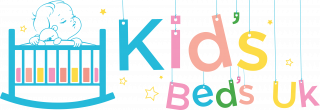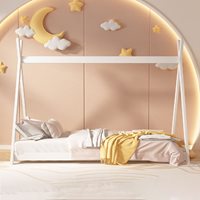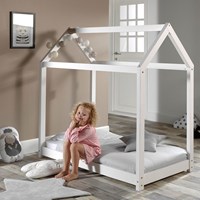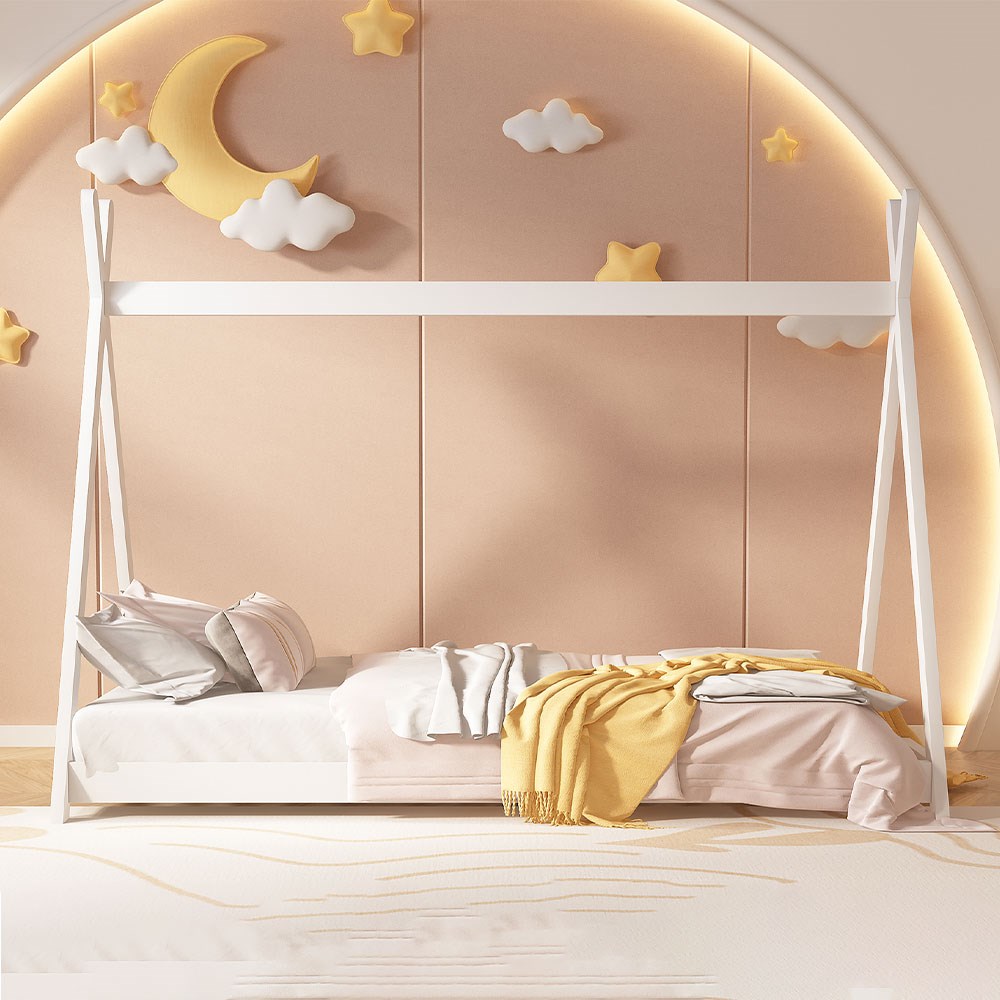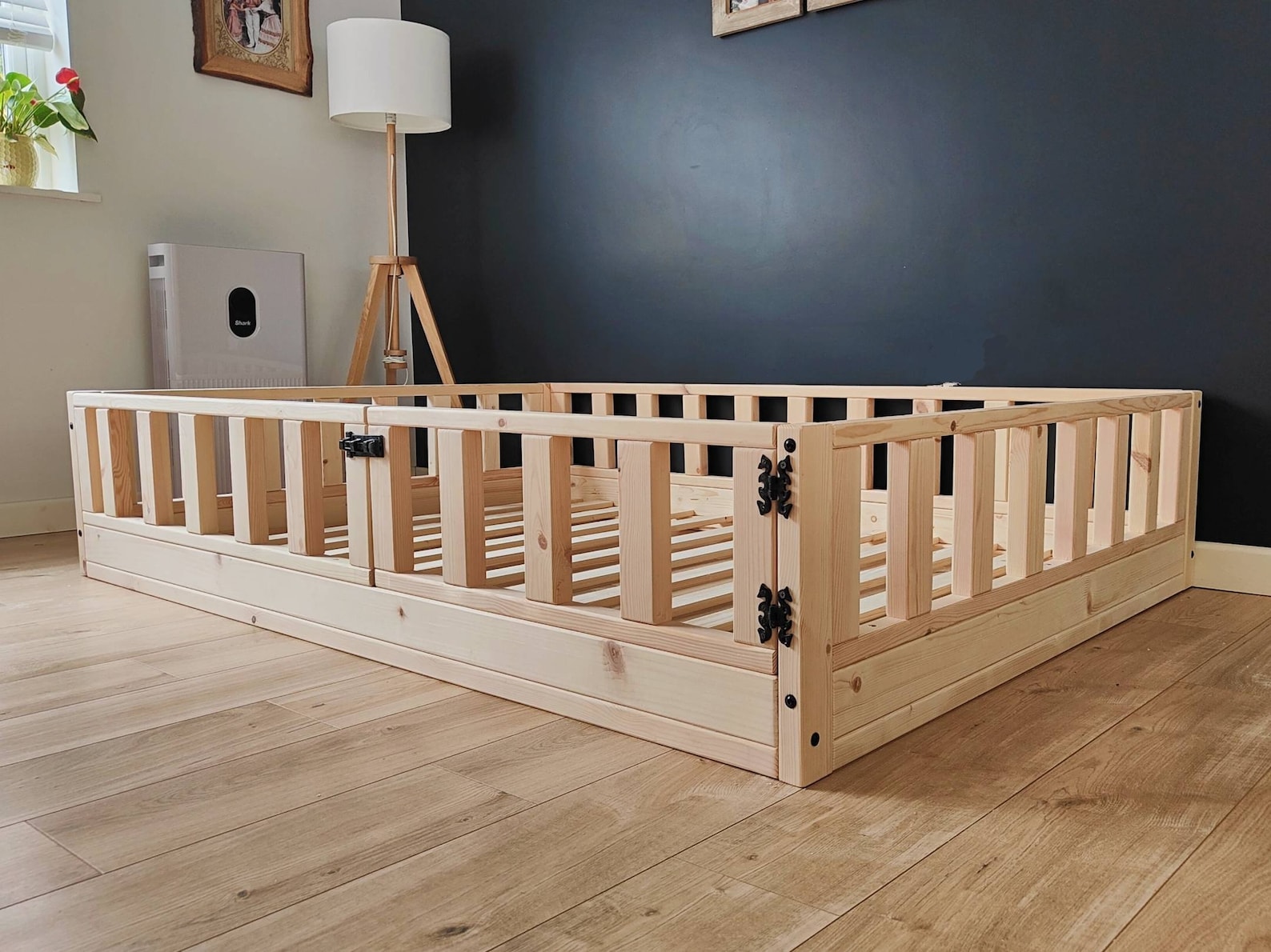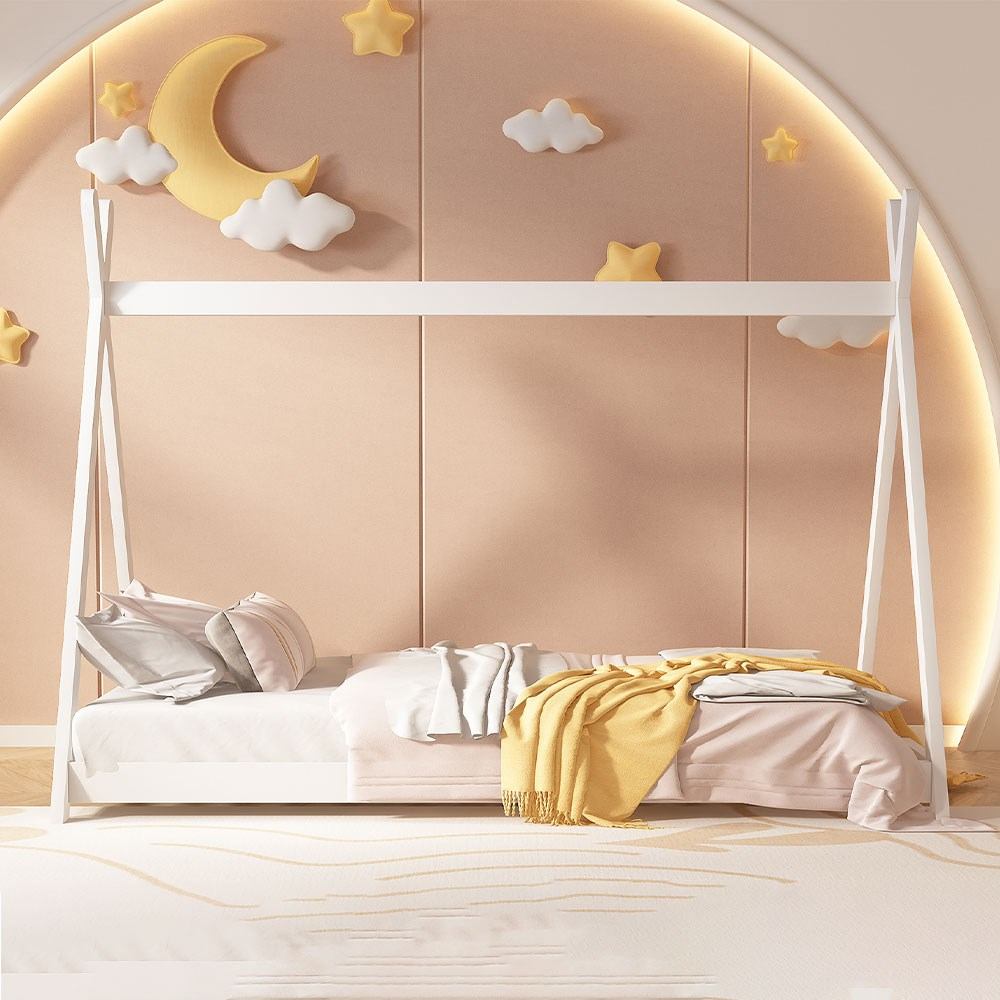
Here are some of the best Montessori Floor Beds you can find on the market in 2023 the UK.

Short Read – Key Takeaways
| Key Factors | Details |
|---|---|
| Safety Considerations | We urge all parents to consider all safety aspects and making an informed choice. Consult the Lullaby Trust and the NHS for safer sleep advice. |
| Concept | The Montessori Floor Bed is a unique concept encouraging independence, freedom of movement, and safety for children. |
| Philosophy | These beds are rooted in the Montessori philosophy. |
| Design | Montessori Floor Beds are placed directly on the floor, allowing children to move freely, safely, and independently. |
| Variety | They come in various types, including beds with rails, Tipi floor beds, house beds, and DIY options. |
| Introduction Age | Many parents introduce a Montessori floor bed as early as 5–10 months, depending on readiness, or you can wait until they are older. |
| Choosing a Bed | When choosing a Montessori Floor Bed, consider factors like material, size, and design. |
| Safety Preparations | It’s crucial to ensure the room is childproof and the bed placement is safe. |
Introduction to Montessori Floor Beds
A Montessori floor bed is more than just a mattress on the floor. It is a concept that has a strong foundation in Maria Montessori’s philosophy of the Montessori method. Its core philosophy is to respect the child. To encourage their independence and freedom of movement, and one that respects a child’s natural development in their own way. This approach often involves a low bed, such as a toddler bed mattress, placed directly on the floor, allowing your little one to move freely in and out without any assistance.
The Benefits of a Montessori Floor Bed
The Montessori Floor Bed offers several benefits that many parents have come to appreciate:
Independence and freedom: One of the main benefits of a Montessori floor bed is the independence and freedom it offers children. Unlike traditional toddler beds with bars, a floor bed allows children to move freely, helping them make their own decisions about when to sleep and when to play.
Promotes self-confidence and curiosity: If a child isn’t ready to sleep, they have the freedom to continue playing or reading as they wish. This autonomy can nurture a sense of self-confidence and stimulate their natural curiosity. In essence, a Montessori floor bed is more than just a sleeping arrangement; it’s a tool that encourages children’s development and respects their individual pace and style of learning.
Safety aspects: With the bed frame close to the ground, the risk of falling from a height is significantly reduced. This makes it a safer option than a traditional raised bed or bassinet, especially for babies and toddlers who are still mastering their motor skills.
Accessibility for children: The low bed design of a Montessori-style bed makes it easily accessible for small children. They can reach their bed comfortably on their own accord, which can be especially beneficial during nap times or nighttime sleep.
When to transition to a Montessori floor bed
The ideal age to introduce a Montessori floor bed varies. Some parents transition their child to a floor bed as early as 2 months; others may transition when they start crawling or are able to lift themselves up; and others may decide to wait until their child is older. You, as a parent, have to be comfortable with your decision.
The key is to observe your child’s readiness. If they show signs of wanting more independence, it might be time to make the switch from the crib mattress to the floor bed. 5–10 months is often cited among Montessori followers. Many decide to go from a Next-To-Me / Co- Sleeper crib directly to the floor bed. Usually, most toddlers transition from a cot to a toddler bed at around 18 months.
Transitioning from a crib to a Montessori floor bed can be a significant change for both the child and the parents. It’s essential to ensure the child’s room is safe for exploration, as your child will now have the freedom to move and learn within their space. We will explore safety in depth further on in the article.
| Age | Key Point |
|---|---|
| 2 months | Some parents transition their child to a floor bed as early as 2 months. |
| 5-10 months | Often cited among Montessori followers as the ideal age to introduce a Montessori floor bed. |
| 18 months | Usually, most toddlers transition from a cot to a toddler bed around this age. |
Mattress Quality: The Essential Component of Montessori Floor Beds
A critical aspect of setting up your child’s Montessori floor bed is selecting the right mattress. The mattress you choose will directly impact your child’s comfort and sleep quality. Here are a few key considerations to keep in mind when selecting the ideal mattress for a Montessori floor bed:
Safety
Above all else, the mattress should be safe for your child. To ensure safety, opt for a mattress that meets the stringent safety standards outlined by the Lullaby Trust or the NHS, especially if it is for a younger child. A firm and flat mattress protected by a waterproof cover will help prevent SIDS. And avoid using soft or bulky bedding.
Comfort
A comfortable mattress is crucial for a good night’s sleep. Look for one that provides the right balance of support and softness. Firm mattresses are generally recommended for younger children to provide adequate support for their growing bodies, while slightly softer mattresses may be more comfortable for older kids. It’s important to note that a mattress that is too soft could pose a suffocation hazard for infants, so always ensure that your choice is age-appropriate.
Durability
Children can be hard on their belongings, and their mattress is no exception. Therefore, opt for a mattress made from durable materials that can withstand some degree of rough handling. Look for a mattress with a robust, tear-resistant cover that can handle the occasional spill or accident. Additionally, investing in a quality mattress can offer long-term savings, as a good one should last through several years of nightly use.
Hypoallergenic
If your child has allergies, a hypoallergenic mattress can help alleviate their symptoms, especially during sleep. These mattresses are designed to prevent the accumulation of allergens like dust mites, mould, and pet dander. Look out for mattresses made from natural materials. We have written a guide on The Best Cot or Cot Bed Mattresses of 2023.
Size
The size of the mattress should correspond with the size of the Montessori floor bed. Typically, these beds are sized to fit standard crib mattresses or single bed mattresses, but it’s always best to check the measurements before making a purchase. Alternatively, you may decide to use it directly on the floor; if so, you will need to limit the risks of entrapment if it’s placed against the wall.
Breathability
A breathable mattress helps regulate temperature and prevents overheating, ensuring a comfortable sleep environment for your child. Look for mattresses made of breathable materials, such as cotton or natural latex.
Remember, your child will spend a considerable amount of time on their mattress. By choosing a safe, comfortable, and durable mattress, you can ensure they get the restful sleep they need for their health and development. Always research thoroughly before making a decision, as this is an investment in your child’s wellbeing.
Pros of Montessori floor beds:
Promotes Independence and Freedom: As we’ve highlighted, Montessori floor beds encourage independence and freedom of movement. They’re designed to respect a child’s natural development and motor skills.
Eases Transition: The transition to a Montessori floor bed can be smoother because it essentially goes directly from a crib to a bed. This can be less stressful for both the child and the parents.
A Lie In For Parents: One of the benefits for parents is that they might not need to get up as early in the morning. If your child wakes up, they can play or read as they please. This could potentially lead to a bit of a lie-in for parents in the morning.
Cost-Effective: Another pro we should mention is the cost. Because you’re essentially skipping the toddler bed stage, a Montessori floor bed can work out cheaper. You aren’t limited to a small cot mattress.
Easier For Cuddles: As previously mentioned, you can hop on closer to your child for bonding and bedtime stories.
Cons of Montessori Floor Beds:
Potential Allergy Risks: It’s often stated that there’s a potential for allergies as the beds are closer to the floor and it’s more difficult to keep clean due to more dust. So, if your child has asthma or allergies, it’s worth considering.
Risk of Mould: Because cots are often raised off the ground, there’s more air circulation. As Montessori beds are closer to the ground, there could be an increase in mould, so you have to keep that in mind and make sure you air the mattress out regularly. Follow care instructions like you would for any cot, or cot bed mattress.
Parental Anxiety: We also need to discuss the potential anxiety for parents. When a child is contained in a crib with bars, they can’t escape that environment, but with a floor bed, they can get up as they see fit. If you’re the type of parent who feels anxious about this, it might not be ideal for you.
Childproofing is Essential: Another con is the need for thorough childproofing. With a Montessori floor bed, the child can get up and explore as they please, which means parents need to be on high alert for potential dangers in the room.
Different types of Montessori floor beds
A Montessori floor bed could simply be a mattress on the floor or any type of bed that is low to the ground. There are several types of Montessori floor beds to choose from, depending on your preference and your child’s needs. Here are a few examples:
Montessori Floor Bed with Rails: This type offers a safety slat around the bed to prevent your child from rolling off while sleeping.
DIY Montessori Floor Beds: For creative and handy parents, making a DIY Montessori floor bed can be a rewarding project. It allows you to customise the bed to your child’s preferences and the room’s layout.
Tipi or a house bed: These are other types of beds, usually made of wood, that are asthetically pleasing and are often low to the floor.
SIDS and Montessori Beds: A Safety Guide
When considering a Montessori floor bed, it’s crucial to be aware of the risks associated with Sudden Infant Death Syndrome (SIDS). Fatherly.com states that “for babies under the age of 1, Montessori beds are a no go, since they fall outside of the safe sleep practises outlined by the American Academy of Paediatrics” and are aimed at reducing the risk of SIDS.
“The American Academy of Paediatrics and the CDC recommend that babies under one year of age sleep on a crib mattress only, as these are much firmer than other types of mattresses and are approved for protection against SIDS. The bed should be free of blankets, pillows, stuffed animals, or anything else other than a fitted sheet.”
For older, more mobile toddlers, Montessori beds themselves don’t pose any grave danger. However, their lack of restriction, which allows kids to get out of bed and explore as they please, means parents need to be on high alert for other dangers in the room. After the age of 3, there’s little difference safety-wise between a Montessori bed and a traditional toddler bed.
Fatherly.com also cites Junnifa Uzodike, an AMI-trained Montessori educator who used a Montessori bed with her three kids from birth. She credits the Montessori bed with her kids’ advanced gross motor skills and independent sleeping. She says that all of her children could get in and out of bed by around 4 months old, so when they woke up in the middle of the night, instead of crying until she came and got them, they could play with toys or crawl to her room if they really needed her.
However, safety is a key concern when considering Montessori floor beds. For infants under one year, these beds aren’t recommended due to the SIDS risks outlined by the American Academy of Paediatrics. For older, mobile toddlers, the unrestricted nature of Montessori beds requires a thoroughly child-proofed room. From age 3 on, safety differences between Montessori and traditional beds are minimal.
In the same article from Fatherly.com Casey Schneider, a paediatric neonatal nurse, first responder for paediatric emergency services, certified infant and toddler sleep consultant, and mom of two, warns that a younger baby could roll off and become stuck between the side and the wall. Therefore, she advises against using a Montessori bed for younger babies due to safety concerns.
Parents should make an informed decision, considering these points and their alignment with the Montessori philosophy. We always stress that parents should look to the NHS and the Lullaby Trust for baby sleep safety guidance. Please check out our references and resources section below. So considering what the experts have said, if you do decide to go ahead with a floor bed, let’s see how we can make it as safe as possible.
How to Make a Montessori Floor Bed Safe
Ensuring the safety of your child is paramount when setting up a Montessori floor bed. Here are some tips:
1. Childproofing the Room: The first step in ensuring safety is to childproof the bedroom. This includes:
- Securing Furniture: Fasten any large furniture pieces to the wall to prevent them from tipping over. Even better, don’t use any large pieces of furniture at all. Aim to create a complete Montessori bedroom.
- Covering Electrical Outlets: Use safety covers on all electrical outlets to prevent your child from inserting objects or fingers into the sockets.
- Removing Small Objects: Clear the room of any small objects that could pose a choking hazard.
2. Safe Bed Placement and Equipment: The position of the bed and the use of additional safety equipment can further enhance safety:
- Bed Positioning: Place the bed away from windows, heaters, and other potential hazards.
- Safety Equipment: Consider using a bed with rails or sides to prevent your child from rolling off and to keep the mattress firmly in place. You do not want your child to become trapped between a wall and the mattress. Placing a soft area rug next to the bed can help cushion any potential falls. Additionally, a baby monitor can provide an extra layer of security by allowing you to keep an eye on your child.
- Safety Gate: With a Montessori floor bed, your child has the freedom to explore. To ensure their safety extends beyond the bedroom, consider installing a safety gate. This can prevent them from accessing potentially dangerous areas of the house.
Considerations for Households with Multiple Children:
If there are other children in the house, you will have another level of issues to be concerned about, so additional precautions may be necessary to ensure the safety of the child using the Montessori floor bed.
Shared Rooms: If the child using the Montessori floor bed shares a room with another sibling, especially if there is an age gap, make sure the older child understands the importance of keeping the room safe. This includes not leaving small toys or other potential hazards in the shared space.
Toys and Games: Older siblings may have toys or games with small parts that are suitable for their age but could pose a choking hazard for younger children. Ensure these items are stored out of reach of the child using the Montessori floor bed.
Simply put, it may not be safe or practical to use a floor bed in a household where there are other children.
Creating a safe environment with a Montessori floor bed is of the utmost importance. By following these guidelines, you can help create a safe and nurturing environment that aligns with the Montessori philosophy.
Environmental Considerations: Maintaining a Clean and Dust-Free Environment for Montessori Floor Beds
The positioning of a Montessori floor bed close to the ground necessitates particular attention to cleanliness and hygiene in the surrounding area. A clean and dust-free environment is crucial not only for your child’s overall health but also for the quality of their sleep. Here are some tips on how to keep the area around your child’s Montessori floor bed clean.
Regular cleaning
Regular cleaning is the cornerstone of maintaining a dust-free environment. Sweep or vacuum the floor around the bed daily to get rid of dust, dirt, and potential allergens. If you have pets, this becomes even more essential to keep pet dander to a minimum.
Air quality
Ensure the room is adequately ventilated to maintain good air quality. Regular airing can help prevent the buildup of dust and reduce the presence of airborne allergens. Using an air purifier can also help, especially in areas where dust or pollution levels are high.
Mattress care
Regularly clean the mattress according to the manufacturer’s instructions. Most crib-sized mattresses come with removable, washable covers. If not, consider investing in a washable mattress protector. It’s also recommended to vacuum the mattress periodically to remove dust mites. Check out our guide on How to Care for Your Baby’s Cot Mattress.
De-clutter the room.
Clutter can collect dust and make cleaning more challenging. Keep the room tidy and decluttered. Provide sufficient storage solutions to ensure that toys, books, and other items are not left on the floor, creating an environment for dust to accumulate.
Use hypoallergenic materials.
When choosing bedding, opt for hypoallergenic materials that resist dust mites and other allergens. Wash bed linens regularly in hot water to kill dust mites and remove allergens.
Regular inspection for mould
As the bed is closer to the ground, it might be more prone to mould growth, especially in damp environments. Regularly inspect the bed and the surrounding area for any signs of mould and address any issues immediately.
Avoid wall-to-wall carpeting.
If possible, avoid wall-to-wall carpeting in your child’s room. Carpets can harbour dust mites, pet dander, and other allergens. Hard floors are easier to keep clean and dust-free.
By maintaining a clean and dust-free environment around the Montessori floor bed, you can create a healthier and more conducive sleep environment for your child. Remember, cleanliness and hygiene are as crucial as comfort when it comes to your child’s sleeping arrangements.
In a study titled “Do Carpets Impair Indoor Air Quality and Cause Adverse Health Outcomes: A Review”, researchers took a close look at how carpets can affect the air we breathe indoors. They found that carpets can hold onto more dust and allergens than floors without carpets. This could make things tougher for little ones with allergies or asthma. The study also pointed out that carpets can give off certain chemicals that might cause irritation. So, if you’re thinking about wall-to-wall carpeting for your child’s playroom or bedroom, it’s worth considering these points. The researchers suggest being extra careful with carpets in spaces where children spend a lot of time, especially if they have respiratory conditions. So in a room where the bed is close to the floor you will need to take this into consideration.
Choosing the Right Montessori Floor Bed
When it comes to choosing the right Montessori floor bed, consider the following factors:
Material: The bed should be made of child-friendly, durable materials. Many Montessori beds are designed with natural wood, which is both durable and eco-friendly.
Size: The size should be appropriate for your child’s age and the room’s size. A toddler may need a bigger bed than a baby.
Design: The design should be simple and functional, aligning with the Montessori philosophy. Some popular designs include house-style beds and Tipi frame beds.
Rails and sides: A bed with rails or sides can help keep the mattress in place while still allowing freedom to leave the bed as your little one sees fit.
There are many popular Montessori floor bed options available on the market, from budget-friendly options to more high-end designs from specialised children’s furniture brands.
Conclusion and Additional Resources and References
A Montessori floor bed can be a great tool to foster independence and safety in your child’s early years, It aligns with the Montessori philosophy of respecting a child’s natural development and providing an environment that encourages learning and exploration. We should also stress that these types of beds may not be suitable for all parents, as childproofing a home where other children sleep may prove difficult. However, if you follow all the guidelines, you may be able to successfully implement one in your home.
For more information, check out the following:
https://www.lullabytrust.org.uk/safer-sleep-advice/mattresses-and-bedding
https://en.wikipedia.org/wiki/Maria_Montessori
https://www.ncbi.nlm.nih.gov/pmc/articles/PMC5858259/
Montessori Floor Beds FAQ
What is a Montessori floor bed?
A Montessori floor bed is a bed that is designed for toddlers and children to sleep on the floor instead of in a crib or regular bed.
What is the idea behind a Montessori floor bed?
The idea behind a Montessori floor bed is to give your child the freedom to move around and explore their environment while also providing a safe space to sleep.
Can a toddler sleep on the floor?
Yes, a toddler can sleep on the floor with a Montessori floor bed. The bed is designed to be low to the ground and safe for young children.
What are the benefits of using a floor bed for a toddler?
Using a floor bed for a toddler can help them learn to make their own bed, promote independence, and give them the ability to move around freely and explore their environment.
When should you transition to a floor bed?
Followers of the Montessori method are recommended to transition to a floor bed when the child is around 5 to 10 months of age or when they start moving around on their own. However, we urge parents to consider waiting until they are older. Consider all safety aspects before making a decision.
How do you transition to a floor bed?
You can transition to a floor bed gradually by allowing your child to take naps on the floor bed first before using it for night-time sleep. You can also involve your child in making their bed to help them feel more comfortable and involved in the process.
What are some bed options for a Montessori floor bed?
There are plenty of options for Montessori floor beds, including house beds, low toddler frame beds with rails, tent beds, and more. It’s important to choose a bed that is right for your child and their needs.
